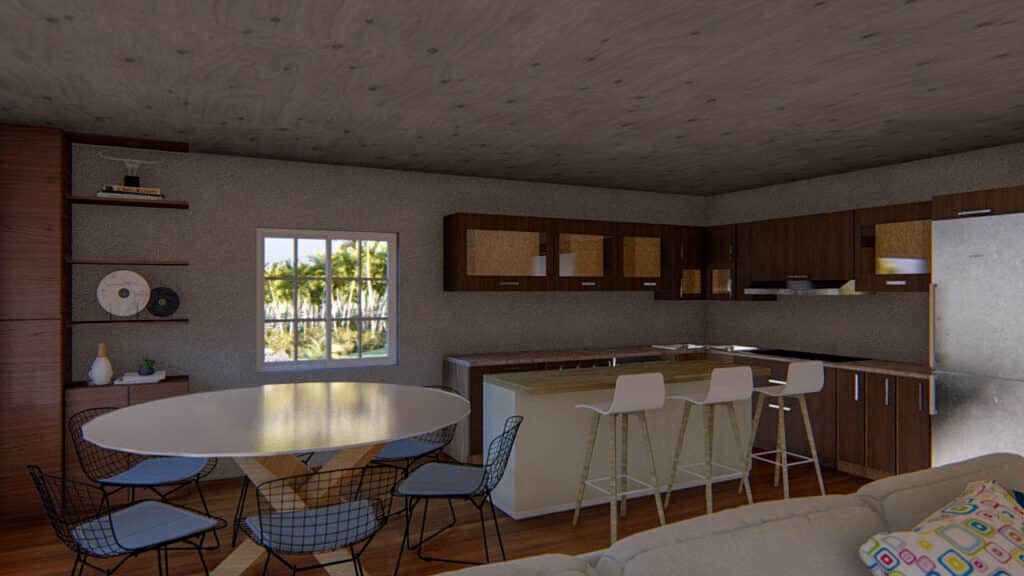Fitting Cabinets, TVs, and Accessories in Cold-Formed Steel (CFS) Framing with 24” On-Center Spacing
Cold-Formed Steel (CFS) framing offers numerous benefits, including durability, fire resistance, and recyclability. However, contractors frequently inquire about the ease of fitting cabinets, TVs, and other accessories when working with CFS framing, particularly with 24” on-center (OC) spacing compared to the more common 16” OC spacing in wood framing. Here, we explore the available options and methods for accessory fitting in CFS-framed buildings.
Available Solutions for Fitting Accessories in CFS
- Use of Magnets for Stud Location:
- Magnets can easily locate steel studs behind drywall, allowing for precise attachment points for accessories.
- Pre-Installation Wood Blocking:
- Before applying drywall, install 2×4 wood blocks horizontally between the CFS studs at desired locations. This provides a sturdy base for mounting cabinets, TVs, or other heavy items.
- Steel Strips During Construction:
- Refer to architectural plans to add horizontal strips of CFS at accessory mounting heights during framing. These strips can serve as built-in attachment points for cabinets or other accessories.
- On request, these strips can be incorporated during the fabrication process, streamlining the installation of accessories post-construction.
- Post-Drywall Wood Attachment:
- Attach a wooden strip directly to the drywall and align it with CFS studs using specialized screws. Once in place, accessories can be mounted to the wooden strip, which distributes the load securely.
- Corner Trim with Infill:
- For cabinets or accessories placed in corners, attach a wooden infill or trim piece to the drywall. This creates a decorative, reinforced surface that can support additional weight while enhancing aesthetics.
- Backing Plates or Bridging:
- Install steel or plywood backing plates between CFS studs during framing to create a continuous, secure surface for mounting. Common materials include 18- or 20-gauge steel strips or 3/4” plywood.
- For attaching trims, cabinets, and other accessories, tools like the Aerosmith VersaPin gun can be used to securely fasten items to the backing or directly to the studs, ensuring a robust installation.
- Specialized Fasteners:
- Use fasteners designed specifically for steel framing, such as self-drilling screws or toggle bolts, to secure items directly to the CFS studs.
- Heavy-duty anchors like Molly bolts or steel expansion anchors can effectively distribute weight across a larger surface area.
- Track Systems:
- Install metal tracks or rails along the CFS studs. Accessories like shelves or cabinets can then be mounted onto these tracks, offering flexibility and strength. This method is particularly useful in commercial applications where frequent reconfiguration is required.
- Additional Vertical Studs:
- For high-load areas, add extra vertical studs between the existing 24” OC spacing to achieve 12” or 16” OC spacing locally. This ensures adequate support for heavy wall-mounted items.
- Custom Cabinetry Design:
- Work with cabinetmakers to design cabinetry that aligns with the 24” OC layout of CFS framing. This minimizes the need for extensive modifications and ensures proper load distribution.
- Drilling Holes in CFS:
- When additional holes are needed in the CFS studs, use tools like step drill bits, self-drilling screws, or a high-speed steel (HSS) drill. These tools make drilling through steel efficient and straightforward.
- Ensure proper alignment with pre-existing framing and structural integrity.
Ease of Accessory Fitting in CFS
- Precision Engineering: CFS framing is dimensionally consistent, which simplifies the alignment and installation of backing plates, tracks, or other support systems.
- Pre-Punched Holes: Many CFS studs feature pre-punched holes for running utilities or adding reinforcements, reducing installation time.
- Lightweight Yet Strong: CFS’s high strength-to-weight ratio means that added supports, such as steel plates or tracks, don’t significantly increase the load on the frame.
Advantages of 24” OC in CFS Framing
While 24” OC spacing may seem less convenient for mounting accessories, it offers benefits such as:
- Reduced Material Usage: Wider spacing requires fewer studs, reducing overall material costs and environmental impact.
- Improved Insulation: The wider gaps allow for larger continuous insulation panels, enhancing energy efficiency.
- Efficiency with Standard Cabinet Sizes: Standard cabinet widths (e.g., 24”, 30”, 36”) align naturally with 24” OC spacing. This can simplify installations, reduce the need for additional modifications, and make mounting more efficient when proper planning is employed.
Conclusion
Fitting cabinets, TVs, and other accessories in CFS-framed buildings with 24” OC spacing is achievable with the right techniques and materials. Using magnets for stud location, pre-installing wood blocks or steel strips, attaching post-drywall wood strips, employing track systems, or drilling additional holes are effective strategies. Additionally, incorporating extra studs or designing custom cabinetry can ensure secure and durable installations. By understanding the unique properties of CFS and planning for its characteristics, contractors can achieve efficient and high-quality results, even with the challenges of 24” OC spacing.


